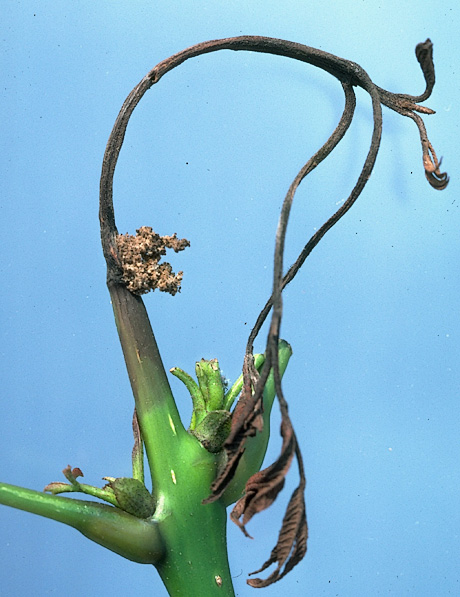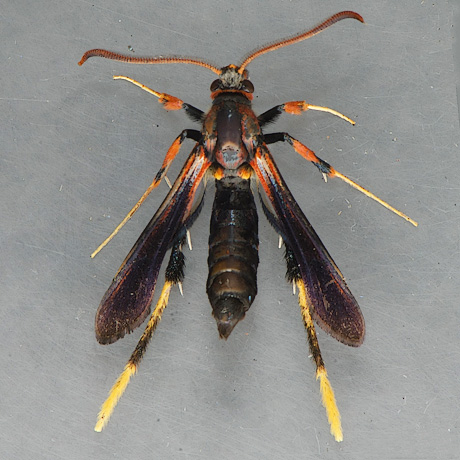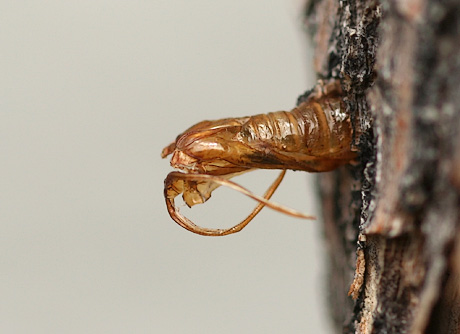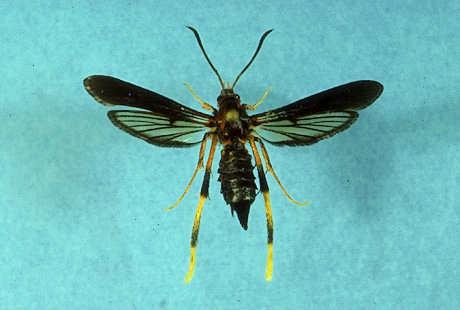
Lilac/Ash Borer
Damage caused by the lilac/ash borer
The larvae of the lilac/ash borer (a grub) tunnels into the trunk and lower branches of ash trees, lilacs and privets, just under the bark. The larvae create round holes in the bark for the adults to use when leaving the tree. Sawdust can sometimes be found on the ground below these holes. Extensive lilac/ash borer damage to the tree trunk can cause gnarled growth, excessive branching or weakened structure. The lilac/ash borers may kill smaller branches by completely girdling them. Most damage occurs under 10' from the ground, and is most common at the soil line.
 James Solomon, USDA Forest Service, Bugwood.org
James Solomon, USDA Forest Service, Bugwood.org
How to identify the lilac/ash borer
The lilac/ash borer (Podosesia syringae) is a moth. The adult lilac/ash borer mimics the Polistes paper wasp. The wings, about 1" in span, are dull black and brown. The body is a dark brown with reddish markings and narrow yellow bands on the abdomen. The lilac/ash borer is one of the few moths that is active during the day.
The lilac/ash borer larvae are creaming white grubs with small dark heads. The lilac/ash borer is the only grub that attacks ash that has prolegs on its abdomen. All the other grubs that attack ash trees are beetles and don't have prolegs on their abdomens.
 Mark Dreiling, Retired, Bugwood.org
Mark Dreiling, Retired, Bugwood.org
Life cycle of the lilac/ash borer
Female lilac/ash borers lay eggs in crevices on the lower trunks of ash trees, lilacs and privets in April.
The eggs hatch 9-13 days later.
The larvae excavate tunnels under the tree bark, eating the cambium and phloem. Then they tunnel into the trunk. When full grown in late winter they tunnel back to the cambium layer just under the bark to pupate.
Adults emerge from holes in the bark on warm spring mornings, during April or May. The adults live for about a week, mating and laying eggs before they die.
 Whitney Cranshaw, Colorado State University, Bugwood.org
Whitney Cranshaw, Colorado State University, Bugwood.org
How to control the lilac/ash borer
The lilac/ash borer usually attacks trees that are stressed due to poor location, lack of water, poor care, previous lilac/ash borer attacks or recent transplantation. Reducing plant stress with proper care can help limit attacks, but chemical control may be recommended until bark is heavy enough to resist injury. We use a foliar trunk spray to control the lilac/ash borer.
 James Solomon, USDA Forest Service, Bugwood.org
James Solomon, USDA Forest Service, Bugwood.org
Other resources
- CSU Extension Fact Sheet
Lilac/Ash Borer: A Common Wood Borer of Colorado's Street Trees - USDA Forest Service
Lilac (Ash) Borer - Utah State University Extension Fact Sheet
Lilac-Ash Borer - Wikipedia: Ash borer
- Kansas State Research and Extension
Problem: Ash/lilac Borer - Podesesia syringae - Virginia Cooperative Extension Publications and Educational Resouces
Lilac Borer/Ash Borer





